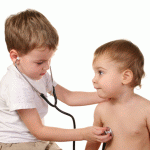Pediatrics
|
25 october 2014 16:48:46 |
| Dose of early intervention treatment during children`s first 36 months of life is associated with developmental outcomes: an observational cohort study in three low/low-middle income countries (BMC Pediatrics) |
|
Tweet Background:
The positive effects of early developmental intervention (EDI) on early child development have been reported in numerous controlled trials in a variety of countries. An important aspect to determining the efficacy of EDI is the degree to which dosage is linked to outcomes. However, few studies of EDI have conducted such analyses. This observational cohort study examined the association between treatment dose and children`s development when EDI was implemented in three low and low-middle income countries as well as demographic and child health factors associated with treatment dose.
Methods:
Infants (78 males, 67 females) born in rural communities in India, Pakistan, and Zambia received a parent-implemented EDI delivered through biweekly home visits by trainers during the first 36 months of life. Outcome was measured at age 36 months with the Mental (MDI) and Psychomotor (PDI) Development Indices of the Bayley Scales of Infant Development-II. Treatment dose was measured by number of home visits completed and parent-reported implementation of assigned developmental stimulation activities between visits. Sociodemographic, prenatal, perinatal, and child health variables were measures as correlates.
Results:
Average home visits dose exceeded 91% and mothers engaged the children in activities on average 62.5% of days. Higher home visits dose was significantly associated with higher MDI (mean for dose quintiles 1-2 combined = 97.8, quintiles 3-5 combined = 103.4, p = 0.0017). Higher treatment dose was also generally associated with greater mean PDI, but the relationships were non-linear. Location, sociodemographic, and child health variables were associated with treatment dose.
Conclusions:
Receiving a higher dose of EDI during the first 36 months of life is generally associated with better developmental outcomes. The higher benefit appears when receiving >=91% of biweekly home visits and program activities on >=67% of days over 3 years. It is important to ensure that EDI is implemented with a sufficiently high dose to achieve desired effect. To this end groups at risk for receiving lower dose can be identified and may require special attention to ensure adequate effect. |
| 97 viewsCategory: Pediatrics |
 Effect of low birth weight on childhood asthma: a meta-analysis (BMC Pediatrics) Effect of low birth weight on childhood asthma: a meta-analysis (BMC Pediatrics)Children`s psychological and behavioral responses following pediatric intensive care unit hospitalization: the caring intensively study (BMC Pediatrics) 
|
| blog comments powered by Disqus |
MyJournals.org
The latest issues of all your favorite science journals on one page
The latest issues of all your favorite science journals on one page



